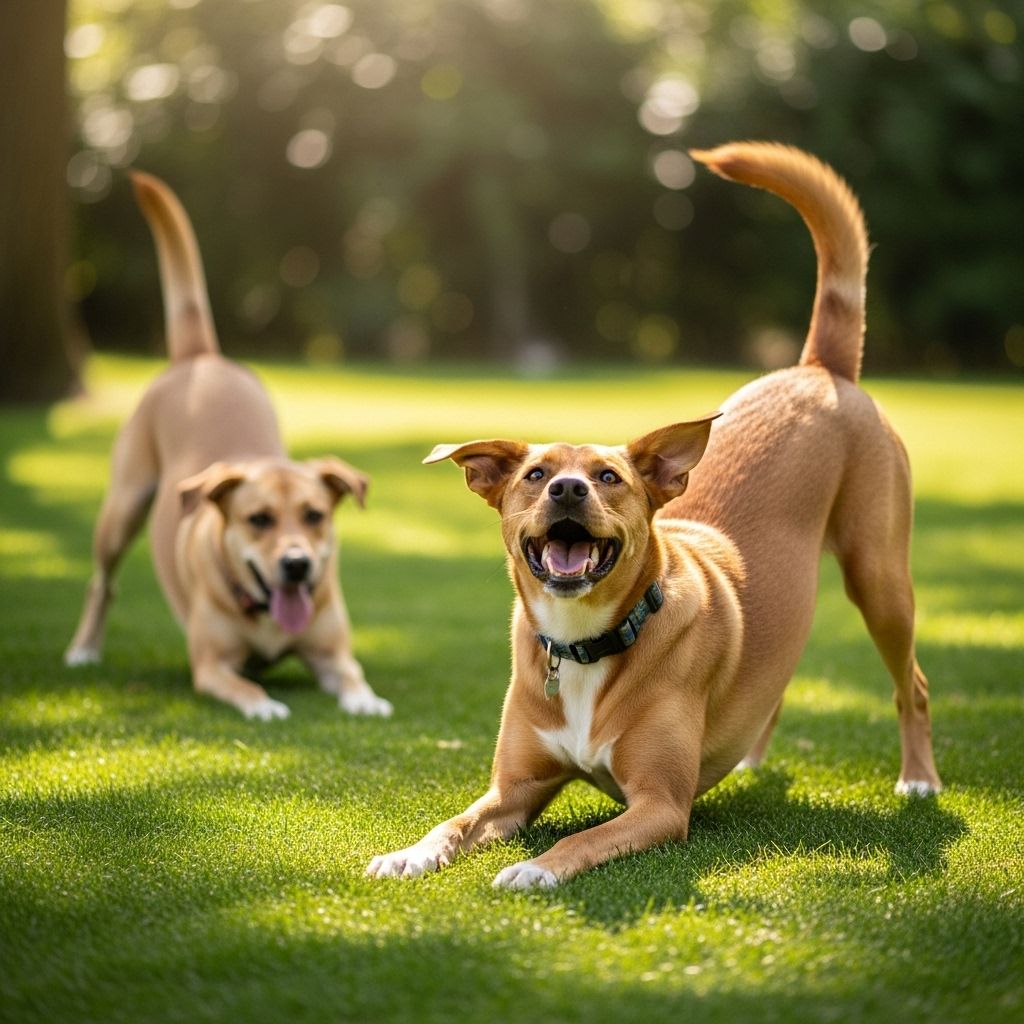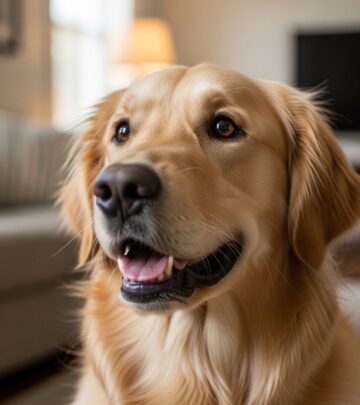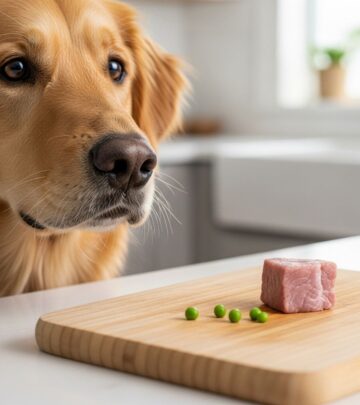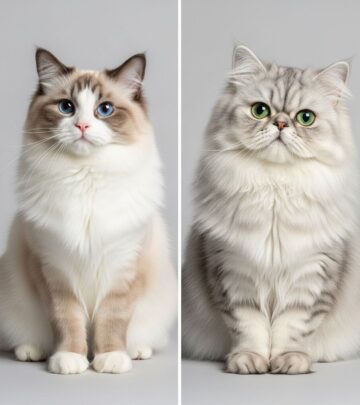Understanding the Dog Play Bow: A Guide to Canine Communication
Unlock the secrets behind your dog's play bow and enhance your connection through canine body language.

The playful posture your dog assumes—front legs stretched forward, tail high and wiggling, rump up in the air—is more than just adorable. This classic gesture, known as the play bow, is one of the most important non-verbal cues in a dog’s repertoire. Unpacking the details of this body language helps improve our ability to communicate with our dogs and ensures their interactions with us and other animals remain positive and safe.
What Is the Dog Play Bow?
The play bow is a distinct canine posture where the dog’s chest and forelegs are lowered to the ground while the rear end is elevated, often accompanied by a wagging tail and an expectant, friendly expression. This stance is commonly seen when dogs are engaged in social activities, signaling that the intent behind their actions is playful rather than aggressive or threatening.
This position is a crucial element of dog-to-dog and dog-to-human communication and should be read in the context of the situation, including what happens before and after the bow, to fully understand your dog’s intention.
Key Features of a Play Bow
- Topline (back) angled downward toward the head
- Forelimbs touching the ground from paw to elbow
- Hindquarters raised
- Tail held horizontally or slightly vertical, typically wagging
- Relaxed and engaged facial expression
- Ears facing forward or relaxed, not pinned back
- Springy, enthusiastic movement (versus stiff or slow motions)
Why Do Dogs Play Bow?
While the play bow is often an invitation to play, its function can expand depending on context and individual dogs. Here are the primary reasons a dog might bow:
- Social Invitation: To encourage play with another dog, person, or even another species.
- Friendly Intent: To signal that whatever follows (chasing, nipping, tumbling) is meant in fun, not as a threat.
- Communicate Non-Aggression: Especially important at the start of play or after a break in play, to signal the playful nature continues.
- Attention-Seeking: Some dogs bow to get their human’s or another animal’s attention when not being noticed during play.
- Stretching: Sometimes, especially after naps, a bow may simply be a satisfying stretch of the spine and legs, not a social cue.
- Apology or Reparation: Dogs may bow as a way to restore friendly intent if play has become too rough or an accidental nip has occurred.
The Play Bow in Canine Communication
Dogs are masters of body language. The play bow is one of their clearest signals for initiating or maintaining friendly interactions. This visual cue tells the ‘bowee’ (the recipient) that the behavior to come is playful, lowering the risk that normal canine roughhousing or even mock-biting will be interpreted as aggression.
Visual Signal: Eyes Matter
Research shows that the play bow is almost always used when dogs (or wolf puppies in experimental settings) are within visual contact of each other. It’s rarer for a dog to perform a play bow when not being watched, and if so, they often bark or make noise to draw attention—demonstrating that play bows are meant to be seen for maximum communicative effect.
How to Recognize a Play Bow
While the broad outline of the play bow is consistent across most breeds, individual dogs may display their own styles due to breed, age, or personality. To recognize a true play bow, look for the following elements together:
- Chest and elbows touch (or nearly touch) the ground
- Hind end remains elevated, tail wagging
- Body appears loose, not stiff or tense
- Accompanied by playful movements (bouncing, spinning, lively motions)
- Facial expression is soft: open mouth, bright or squinty eyes, ears forward or relaxed
Sometimes, especially in puppies and energetic breeds, the bow is repeated in quick succession or paired with other playful behaviors like the ‘play dance’ or excited barking.
Dog Play Bow vs. Prayer Bow: How to Tell the Difference
Not all bows should be interpreted as a play invitation. There are two primary types:
| Bowing Style | Main Features | Likely Meaning |
|---|---|---|
| Play Bow | Chest down, rump up, tail wags, springy movement, relaxed face | Wants to play, friendly, asking for attention or engagement |
| Prayer Bow | Stretches front down, rear may not be high; slower, holds position; may occur after eating or waking | Stretching, possibly discomfort (e.g., gastrointestinal pain), not typically a play invitation |
The context and frequency also matter. Repeated prayer bows, especially if coupled with other signs of illness (lethargy, vomiting, abnormal posture after meals), can indicate medical issues such as bloating or pancreatitis—prompting a veterinary checkup is a wise precaution in such cases.
What Does It Mean When a Dog Bows at You?
If your dog gives you a play bow, it is a clear invitation to interact. This is a sign of trust and enthusiasm, strengthening the bond between you and your dog. Dogs often bow to their humans to initiate games, chase, or simply get your attention in a fun and friendly manner. Reacting by engaging in play will affirm your relationship and reinforce this positive social cue.
Play Bow as a Universal Signal
While play bows are a nearly universal dog behavior, their use can extend to other species, and even human-dog play. Pet parents can try imitating the gesture to initiate play with their dogs—leaning over, elbows bent, and making an energetic movement. Many dogs recognize this mimicry and will happily respond, promoting interactive play and shared joy.
What the Experts Say: Behavioral and Veterinary Insights
Leading animal behaviorists and veterinarians emphasize the importance of context in interpreting bowing behavior:
- Dr. Claire Smith (Animal Behaviorist): “The play bow is a fundamental indicator of playful intent that prevents misunderstandings and supports safe socialization.” Repeated bows outside a playful context can signal discomfort.
- Dr. Amy Johnson (Veterinarian): “Frequent prayer bows post-meal may indicate gastrointestinal issues. If accompanied by other signs like vomiting or lethargy, consult your vet promptly.”
- Mechtild Käufer (Author, Canine Play Behavior): Play is a key mechanism for creating joy and connection between people and their pets, with the play bow as a central and joyful signal.
When Should You Be Concerned About Dog Bowing?
In most cases, bowing is a normal, healthy behavior. However, bowing may point to an underlying issue if:
- Your dog frequently performs prayer bows after eating
- Bowing is accompanied by signs of distress: whimpering, lethargy, vomiting, difficulty standing
- Bowing comes with excessive licking of the abdomen or obvious discomfort
- Your dog avoids normal activities or seems unable to settle comfortably
If you notice any of these warning signs, seek veterinary attention. Early intervention can make a significant difference if the cause is medical (such as bloat, pancreatitis, or musculoskeletal pain).
Enriching Your Relationship Through Play Bows
Engaging with your dog in games that involve bowing—like chase, fetch, or tug-of-war—supports mental stimulation, physical exercise, and deeper connection. Recognizing play bows and responding positively can help strengthen your dog’s sense of security and joy at home.
Frequently Asked Questions (FAQs) About Dog Play Bows
Q: Are play bows only directed toward other dogs?
A: No, dogs often play bow to humans, other animals, and sometimes even to invite objects (like toys) as part of playful ritual. The gesture reflects sociability, not just inter-dog communication.
Q: Can people mimic the play bow to play with their dogs?
A: Yes! Many dogs respond enthusiastically when their humans mimic a play bow. Move quickly into the position for a playful effect, and follow with interactive play such as chase or tug-of-war.
Q: Is the play bow the same in all breeds?
A: The core gesture is shared by most breeds, but the specific appearance can vary based on the dog’s size, energy level, and personality. Some dogs combine the bow with excited barks or spins, while others may hold still and wag their tails vigorously.
Q: How can I tell if a bow is playful or a sign something is wrong?
A: Context is key. Play bows are energetic, relaxed, and followed by play. Prayer bows (associated with stretching or discomfort) lack bounce and may be repeated frequently, especially after meals, suggesting a need for a health check if other symptoms present.
Q: Do wolves use play bows the same way as dogs?
A: Research indicates that while both wolf and dog puppies use play bows, only dogs consistently use this gesture to successfully invite further play. In wolves, the signal is less often followed by continued playful activity, suggesting a species difference in social signaling.
Other Canine Play Signals to Watch For
- Play Dance: Quick, sideways skipping or bouncing in place, sometimes combined with play bows
- Excited Vocalizations: Short, happy barks or yips during energetic play
- Happy Tail Wag: Loose, full-body wag, usually high or mid-level, never stiff or tucked
- Puppy Spins: Rapid circular runs, often seen in young and highly excitable dogs
Paying attention to these signals allows for more nuanced understanding of what your dog is communicating and enhances the potential for rewarding interaction and safe play.
Summary Table: Dog Play Bow Quick Facts
| Aspect | Description |
|---|---|
| Posture | Chest down, rump up, tail means play |
| Purpose | Initiates or maintains play, signals non-aggression |
| When to Worry | If repetitive post-meal or linked to digestive trouble, consult vet |
| Human Involvement | Can be mimicked for interactive fun |
Conclusion: The Lasting Importance of the Play Bow
Understanding the dog play bow unlocks a crucial aspect of canine communication. Not only does it allow you to respond to your dog’s joyful invitations, but it also helps you distinguish between healthy play and signs that warrant medical attention. Celebrate the play bow as a gateway to deeper understanding, mutual trust, and the pure joys of play—both for you and your beloved canine companion.
Read full bio of medha deb












